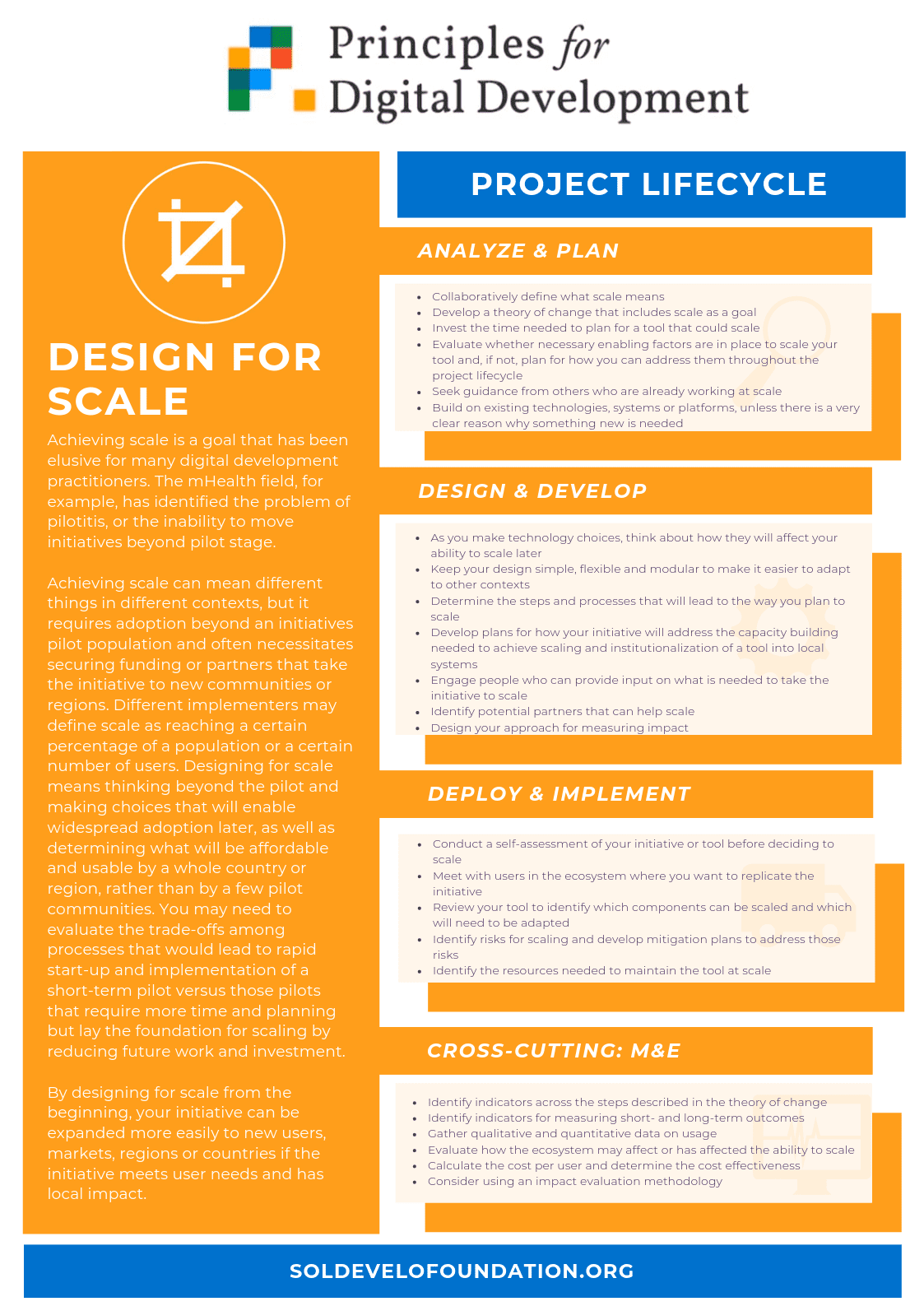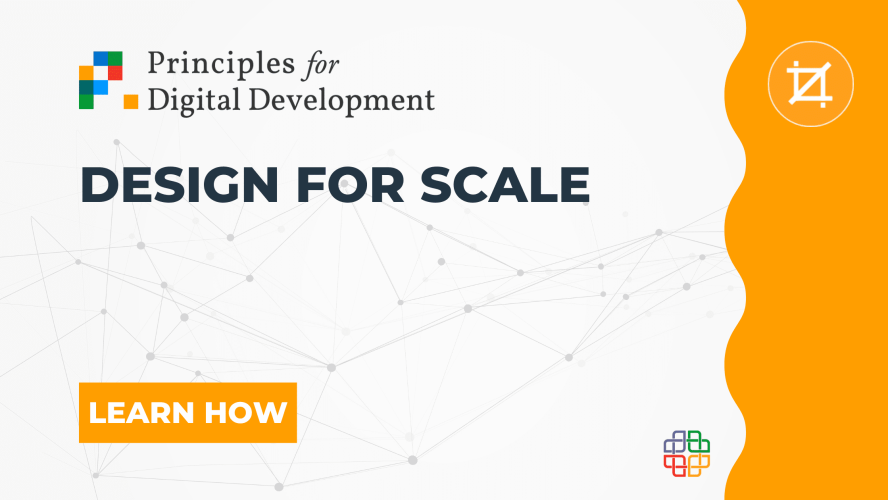In the last article dedicated to the Principles for Digital Development, we talked about designing for users and thinking about the ecosystem of the project. Now we want to focus on design for scale. Making the best possible for society is the main goal of nonprofit organizations. They want to do many things bigger, better and encourage more people. But do they know how to do this right and properly? Even a good idea without a good plan and preparation is doomed to failure.
Designing for scale needs a bigger overall view and knowledge. It also means using functionality which will be easy to adapt and widespread. Achieving scale requires regular and secure funding and often partners which help share the initiative to new people or regions. You may need to think about the pros and cons of implementation of short-term projects and long term. The long-term implementations may need more time and planning. But in the future, scaling will reduce work, investment and at the end – money. Ability to changes and adjustment often condition the success and strength of the company. During progress and thinking about new steps always look into the future and how it helps you and affect your work. Analyze and think about these aspects:
- when you start your project, plan and design for the scale
- expand your “scale” during the work
- make it easy to adapt – keep it simple, flexible and easy to use
- think about what will make your project easier in the future also in the aspect of technology choices
- search for partners and fundings early to scale your project, tool or idea
- gather evidence, demonstrate impact before trying to scale your project
- carefully think about needs, usefulness and utility before attempting to grow bigger
Analyze & Plan
In designing for scale you have to think about a big impact and a huge scale from the start. Resources you will use should run longer and be more efficient to be appropriate for the scale. Also in proposals, you can signal that the long-term impact is your goal. Even if it’s not required you can include it in your vision to show others your global and future thinking. Many organizations (and, what can be even more important, founders!) prefer to be a part of long-term projects with vision than only be a member for a few months. By doing this you can interest some people and they can keep their fingers crossed for you and your success in the future. There is also a big chance that you will meet them again.
Make sure that you and your partners think about the same meaning of “scale” and end goal. Create plans that are agile. Make changes while are you scaling. This process will allow you to include activities necessary to reach a goal. Investment in technology, tools and ideas. Especially in the time that your project could potentially scale into something larger. Investing now rather the later affects your budget and in some way timeline. At the same time helps you build a future idea and saves money because your project won’t need changes. They will be ready for working for the bigger crowd. Also, you can look for help and bits of advice from others especially if they work themselves on a larger scale. You don’t have to learn everything from scratch. It is always better to learn about the successes and failures of others.
Design & Develop
Use information gathers during research and from your partners to inform your design. Try to not make the same mistakes as your predecessors in their projects. During the process, you may find that something needs to be rebuilt or recreate. Don’t avoid it, be flexible to implement new but think about doing for the future to avoid the situation like that. You have to think where you will be working and for how specific group you will create.
Work with people who can provide what is needed to take the initiative to scale. Think about everything you will need during implementations and working with other companies, organization or even governments. Find local partners that can help scale. If everything will be good they will want to work with you in the future projects in new destinations. Focus on demonstrate them benefits from the relationship and social impact.
Deploy & Implement
When you launch your project you will get a lot of data from the target audience which will be important in making the next decisions. Gather feedback, analyze and change your plan. Remember to book time, resources for changes or initiatives that will save your project and help it scale up.
You can meet with recipients to get to know their expectations and how they imagine it. Discuss priorities whether they want to talk with you about it. You can’t attempt to scale without understanding the existing ecosystem. Before every scale, discuss what features can be scaled and which will need to be adapted. Compare it with the information you got from volunteers and data.
Identify risks like low interest or many complains and develop solutions for it. For each risk make a brainstorm how to minimize it, avoid and what is the fastest way to repair it. Make a judgment where you scale each risk and give it a priority so you know how big has its impact on. At the end identify resources (money, time, workforce, partners etc) needed to maintain the project at scale.
Cross-cutting
Do you know when you should scale with your initiative? When is your time to act? And how to know is your idea is successful? To don’t miss out on this time you have to monitor the impact of your initiative and analyze data. If your project has a lower interest from the audience than you thought, it may need redesign before attempting to scale. It may be even not enough friendly for your audience so you shouldn’t attempt the scale with it. That’s why is so important to gather information from researches, people you are working for and other data.
Set indicators for measuring long and short-term outcomes. You see which changes have the biggest influence on popularity and in which direction you should go. It also helps you forecasts trends and time when you will be able to scale.
Last step
At this phase, you should exactly know and understand the existing ecosystem. So it will be easy to evaluate how the ecosystem may change your initiative and its ability to scale in a period of time. Before every implementation in new region/culture etc, you should think about features which may affect on your idea and how they change it.
When you will have everything ready it’s time to calculate costs. The costs per person, and it’s effectiveness. They help you in estimations if scaling is realizable or not. Final costs may show that your project’s pricing is lower than other already made or it’s more expensive. Then you should think about utility the most expensive things. In projects with a limited budget, try to prepare the best project as you can so that people, organizations and donors come to you.
The lifecycle of “Design for Scale

To help you apply the “Design for Scale” Principle in your digital projects, the creators of the initiative provide a guide. You can find it here.
Continue your journey with the Digital Principles and read about the 4th one – “Build for Sustainability“:
Learn to use Digital Principles in practice:
Digital Principles Organizational Self-Assessment
Digital Principles Indicator Library
Digital Principle-Focused Evaluation
The Principles For Digital Development: Gold Practices




